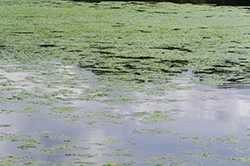Technical Assistance in State and Local Response to Harmful Algal Blooms

HSB provides technical assistance and consultation to public health representatives to develop their public health responses to HAB events. If you need technical assistance about a HAB in your community, please contact the Health Studies Branch at 770-488-3410 or email us at cleanwaterforhealth@cdc.gov.
Here are two examples:
-
2014-2015. The State of Ohio Department of Health requested assistance from CDC in preparing for possible microcystin contamination in drinking water derived from Lake Erie. A large Microcystis aeruginosa bloom formed in the lake and was predicted to be worse than the bloom of 2014. The state specifically asked if their recommendation that vulnerable populations (e.g., immunocompromised patients, pregnant women) follow EPA’s new guidelines for exposure to microcystin-LR for children.
HSB collaborated with NCEZID and EEHS to create a response supporting their recommendation as reasonable since it offers similar guidance to what is offered by EPA (EPA 2015. Drinking Water Health Advisory for the Cyanobacterial Microcystin Toxins (see http://www2.epa.gov/sites/production/files/2015-06/documents/microcystins-report-2015.pdf [PDF - 896 KB], page 2). HSB and NCEZID also collaborated to provide assistance in addressing specific uses of water from the public water system, including household use and use in hospitals, restaurants, and other venues
-
2015. The National Parks Service (NPS) in Nevada requested assistance in addressing the public health effects associated with a cyanobacteria bloom in Lake Mead. The bloom was an unusual event likely driven by the long regional drought. HSB provided materials from the Harmful Cyanobacteria Tool Kit and participated in outreach and education with the public and medical communities. HSB also assisted in consolidating bloom-related illness surveillance by creating a process to collect all reports of bloom-associated health symptoms in one place.
- Page last reviewed: April 1, 2016
- Page last updated: June 21, 2016
- Content source:


 ShareCompartir
ShareCompartir